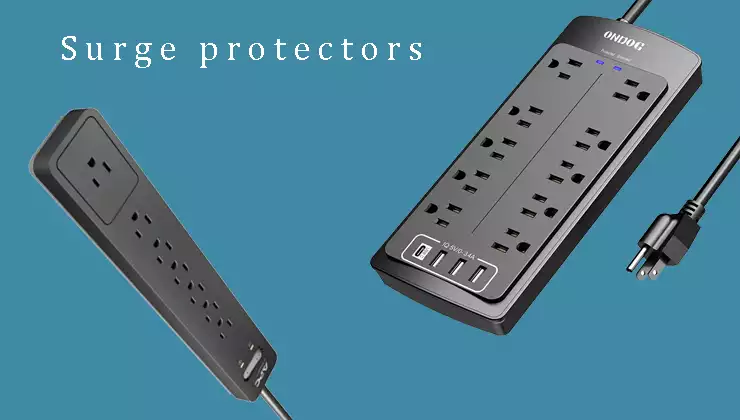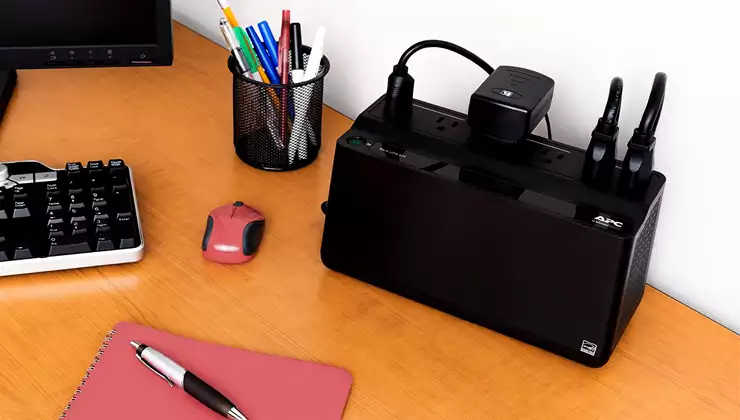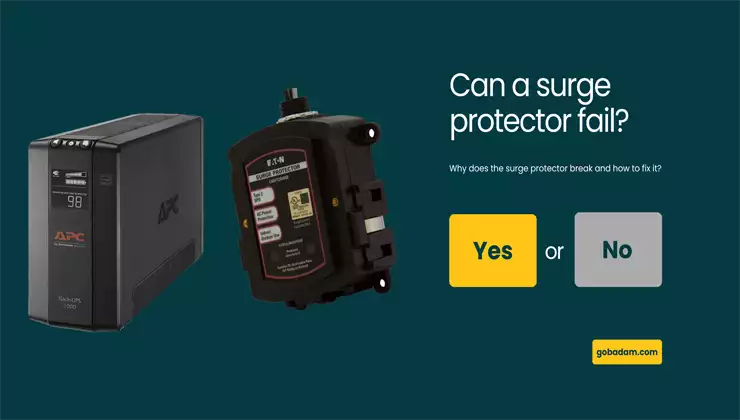If you’re asking if the surge protector fails, the answer is yes, surge protectors can fail over time.
Surge protectors do not have an expiration date in the same way that perishable products do. However, their effectiveness, such as lava lamps, may decrease over time and it is usually recommended to replace them every few years to ensure they still provide adequate protection.
The lifespan of a surge protector can vary depending on a number of factors, including the quality of the components, the number of surges it has been subjected to, and the amount of use it has received.
In this article, we will learn about the reasons for the failure of the surge protector and how to understand it.
How do I know if the surge protector has failed?
There are a few signs that a surge protector may have failed:
- No power: If a surge protector is not providing power to the devices it’s protecting, it may have failed. This can be due to a malfunctioning outlet, damaged cords, or a failed component.
- Flickering lights: If the lights connected to a surge protector are flickering or dimming, it may be a sign that the surge protector has failed. This can be caused by a malfunctioning component or a problem with the outlet.
- Burned smell: If you notice a burned smell coming from a surge protector, it may be a sign that it has failed. This can be caused by a malfunctioning component or an electrical problem.
- Physical damage: If a surge protector shows signs of physical damage, such as frayed cords, damaged outlets, or a broken casing, it may have failed.
If you notice any of these signs, it’s a good idea to stop using the surge protector and replace it. Continuing to use a failed surge protector could potentially damage your devices or cause an electrical fire.

Why does a surge protector break?
There are a few different things that can cause a surge protector to fail. These; Deterioration due to wear and tear, deterioration due to overloading, and overuse protectors may deteriorate due to prolonged use.
Failure of the surge protector due to wear and tear
Yes, surge protectors can fail due to wear and tear. The metal oxide varistor (MOV) components that help protect against surges can degrade or fail over time, especially if the surge protector has been subjected to multiple surges. The connectors and outlets can also become damaged or worn due to frequent use.
To help prevent a surge protector from failing due to wear and tear, it’s important to use it as intended and avoid overloading it. It’s also a good idea to replace surge protectors every few years to ensure they are still providing adequate protection. If a surge protector shows signs of wear or damage, such as damaged outlets or frayed cords, it should be replaced to ensure it is still able to provide proper protection.
Yes, surge protectors can fail due to wear and tear. The metal oxide varistor (MOV) components that help protect against surges can degrade or fail over time, especially if the surge protector has been subjected to multiple surges. The connectors and outlets can also become damaged or worn due to frequent use.
To help prevent a surge protector from failing due to wear and tear, it’s important to use it as intended and avoid overloading it. It’s also a good idea to replace surge protectors every few years to ensure they are still providing adequate protection. If a surge protector shows signs of wear or damage, such as damaged outlets or frayed cords, it should be replaced to ensure it is still able to provide proper protection.
Can the surge protector fail due to Overloading?
Yes, surge protectors can fail due to overloading. If you use a surge protector to protect devices that draw a lot of power, such as appliances or large electronics, it can become overloaded and fail. This can happen if the total power draw of the devices being protected exceeds the surge protector’s rated capacity.
To prevent a surge protector from failing due to overloading, it’s important to use it as intended and not exceed its rated capacity. You can find the rated capacity of a surge protector by looking at the label or packaging. It’s usually expressed in watts or amps. Make sure the total power draw of the devices you’re protecting is within the surge protector’s rated capacity.
It’s also a good idea to use a surge protector with a higher capacity than you need to allow for some margin of error. This can help protect against accidental overloading. If you’re not sure how much power your devices are drawing, you can use a wattmeter to measure the total power consumption.
Can the surge protector fail due to Age?
Yes, surge protectors can fail due to age. As surge protectors age, their ability to protect against surges may decline. This is especially true if the surge protector has been subjected to multiple surges or has been in use for an extended period of time. T
he metal oxide varistor (MOV) components that help protect against surges can degrade over time, and the connectors and outlets can become damaged or worn due to frequent use.
To help prevent a surge protector from failing due to age, it’s important to replace it every few years to ensure it is still providing adequate protection.
If a surge protector shows signs of wear or damage, such as damaged outlets or frayed cords, it should be replaced to ensure it is still able to provide proper protection. It’s also a good idea to use a surge protector as intended and avoid overloading it to help extend its lifespan.
Surge protector Failure due to physical damage
Yes, surge protectors can fail due to physical damage. If a surge protector is subjected to physical trauma, such as being dropped or knocked over, it can break or malfunction.
Physical damage can cause the metal oxide varistor (MOV) components that help protect against surges to fail, and it can also damage the connectors and outlets.
To prevent a surge protector from failing due to physical damage, it’s important to handle it with care and avoid subjecting it to rough handling or impacts.
If a surge protector shows signs of physical damage, such as frayed cords, damaged outlets, or a broken casing, it should be replaced to ensure it is still able to provide proper protection. It’s also a good idea to use a surge protector as intended and avoid overloading it to help extend its lifespan.

How to identify safe surge protectors?
Here are a few tips for identifying safe surge protectors:
- Look for certification: A surge protector that has been certified by a reputable organization, such as Underwriters Laboratories (UL) or the International Electrotechnical Commission (IEC), is more likely to be safe. These organizations test and certify surge protectors to ensure they meet certain safety and performance standards.
- Check the rating: Make sure the surge protector you choose has a high enough rating to protect your devices. Look for a surge protector with a high joule rating, which indicates the amount of energy it can absorb. A higher joule rating means the surge protector can protect against more powerful surges.
- Consider the clamping voltage: The clamping voltage is the voltage at which the surge protector begins to divert excess voltage away from your devices. A lower clamping voltage is generally better because it means the surge protector will begin protecting your devices at a lower voltage.
- Check the warranty: A surge protector with a good warranty is generally a sign of a quality product. Look for a surge protector with a long warranty period, and make sure the warranty covers both the surge protector itself and any devices it protects.
By following these tips, you can help ensure that you are getting a safe and effective surge protector.

What are the best surge protector brands?
There are many reputable brands that offer high-quality surge protectors. Some of the best surge protector brands include:
APC: APC is a well-known brand that offers a range of surge protectors for both home and office use. Their products are known for their high quality and reliability.
Belkin: Belkin is another well-known brand that offers a variety of surge protectors for home and office use. Their products are known for their high joule ratings and excellent warranties.
Eaton: Eaton is a respected brand that offers a range of surge protectors for both residential and commercial use. Their products are known for their high joule ratings and reliable protection against surges.
Leviton: Leviton is a trusted brand that offers a range of surge protectors for both residential and commercial use. Their products are known for their high joule ratings and durable construction.
Tripp Lite: Tripp Lite is a reliable brand that offers a variety of surge protectors for both home and office use. Their products are known for their high joule ratings and excellent warranties.
There are many other reputable brands that offer high-quality surge protectors, so it’s important to do your research and choose a product that meets your needs and budget.
SEE OFFER 👉🏻 surge protector tower with usb ports
Surge protector failure questions
In how many years it is necessary to replace surge protectors?
Surge protectors wear out and deteriorate over time due to surges. It is recommended that you change it regularly every year for the safety of both you and your devices.
Can surge protectors be repaired?
To repair surge protectors, you must first find the cause of the fault. Since surge protectors are prone to fire, we recommend that you buy a new one instead of repairing it.
Also, do you know the lifespan of the most preferred Airtag? Here’s to you, Does Airtag have a lifespan?

